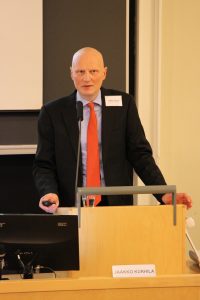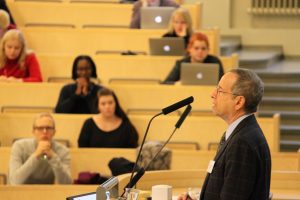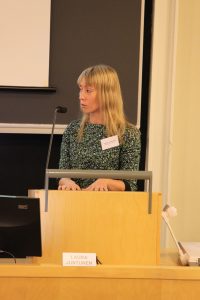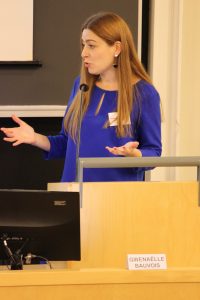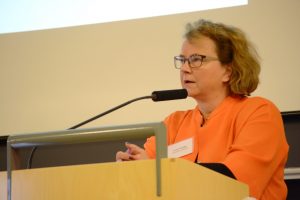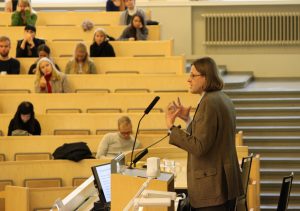250 Symposium – RIGHT TO KNOW
TRANSPARENCY AND OPENNESS IN PUBLIC LIFE
University of Helsinki, 14.10.2016
(Please note that you can watch the full recording from the symposium here.)
Summary:
Opening words: Open knowledge and Science – Tiedon ja tieteen avoimuus
By Jaakko Kurhila, PhD, Rector of the Open University at the University of Helsinki
The main point underpinning Dr. Jaakko Kurhila’s brief opening speech was an acknowledgment that all things being ‘open’ is a crucial issue nowadays. For instance, the Ministry of Education aims for Finland to be one of the top countries in the world for open science and research by 2017.
Kurhila argued that openness is key to the development of society, as was the view 250 years ago when the Freedom of Information Act was passed. Additionally, he stated that openness is a winning strategy, citing examples of open software such as Linux as the key pillars of Internet structure—and the Internet in itself as crucial in order to make openness possible.
Furthermore, he pointed out, in learning openness is required: learning is about change. Essentially, all ‘open’ things in the realm of learning and education contribute to this perspective: open education, open courses, open pedagogy…. But Kurhila presented an interesting perspective: is the right to know enough? Studies show that in some cases openness can lead to more inequality as it is already privileged users who engage in it. Only by ensuring that everyone can know and access and benefit from open education will it lead to more equality and democratisation of learning. Also, opening up education would make it more visible, enhancing its quality and increasing its impact. Using open resources and licenses is key to the development of education and thus society.
We are approaching an era where if something is not openly accessible, it does not exist. As Kurhila highlighted, libraries put a lot of effort and money into licensing, but this does not alter the fact that people are not usually concerned if materials are not openly accessible. There are also other issues: we produce data when we are online, which turns us into commodities. We lack the right to own, know and inspect our own data.
He concluded his speech with a fitting quote from 1987 by Stewart Brand: “Information wants to be free. Information also wants to be expensive … that tension will not go away”. This was an adequate note to start the rest of the talks, which elaborated on this perspective from different angles: what should be open? What can be open? For whom, and under what circumstances?
(Esther Veas)
Keynote speech: The Right to Know
By Professor Michael Schudson, Journalism, Columbia University (New York)
Professor Schudson’s speech was focused on tracking the origins of The Right to Know through an American perspective. His talk, homonymous with his latest book, started by quoting a pamphlet from the 1760s, a clear reference to the 1766 Swedish law that this Symposium was commemorating. He stressed that American Freedom of Information Act, therefore, was not the first of its kind, but the second or third depending on how Finland and Sweden are counted. Schudson noted that why it arose in Sweden and nowhere else in 18th century Europe is a very interesting question.
In the case of the United States, this law comes at most as a ‘remote descendant’ of the 18th century Enlightenment. The 1966 Freedom of Information Act, or “FOIA” for short, is a super statute, penetrating public normative and institutional culture in a deep manner. Schudson argues that we need to look at the past 50 or so years, roughly since 1945, to find out about its specific origins and limitations.
Schudson then proceeded to pit two very different cultural landscapes against each other: that of the United States in the 1960s against the late 1980s. In the former, he recounted, 12% of doctors informed their patients that they had cancer, and there was no consumer-friendly labelling in supermarket products. However, by 1988, 98% of doctors shared this information; and terms like whistleblower or informed consent were much more widespread. Thus, this begs the question: “how can we understand this cultural change?”
Firstly, Schudson outlined some mistaken responses to these changes towards expectation of openness, such as the misinformed view that this was a key value for Founding Fathers. Another mistaken view is that the period of social revolutions that happened in the 1960s had a part to play; this is, according to Schudson, a “more serious hypothesis”, but it still does not explain the full picture.
The roots of FOIA, then, lie within John Moss’s efforts. Moss, a member of the US House of Representatives in the 1950s, began campaigning for this law after being denied information regarding civil service employees. He accused Washington of deploying “paper curtain” tactics of executive secrecy, and the Eisenhower administration for their “Soviet-style control of the news”, where only good news was shared with the American public. After 12 years, FOIA became law in 1966.
The passage of the Freedom of Information Act and its 1974 amendments were the point of origin for a worldwide spread of freedom of information that, in a key decade between the fall of the Soviet Union in the 1990s and 9/11, would reach all over the globe. But, as Schudson asked, why did it happen when it did? Schudson argued that part of the answer lies in the Cold War rationale. If the Soviet Union were closed, it was US citizens’ duty to be open, as good democratic citizens should be. Higher education also played a role in this shift, as did a ‘shared ideal of critical scrutiny’ in journalism that started in the 1960s.
A very interesting point in this keynote came with the closing remarks. Is full transparency actually a good thing? Schudson introduced the idea that openness may not be a supreme good by referring to instances where non-transparency can be a protective measure, to safeguard privacy and intimacy at a personal level; or issues of national security in the public sphere. This is, in his opinion, where the discussion for the next 250 ought to start: democracy, after all, is a “very complicated balancing act”. Anyone advocating for FOIA and its values should be prepared to consider a philosophy of when transparency is not the best policy.
PhD student Laura Juntunen’s comments on this keynote stemmed from the perspective of journalism. She noted that although Nordic countries are often regarded as “pioneers” in openness and transparency, in practice, journalists complain of finding difficult to access information that should have been made public in the first place.
She went on to highlight that a process of accountability implies an external entity applying pressure; otherwise, transparency requirements are easily ignored. Juntunen mentioned that, with journalists’ close ties to politicians until recent years and the decline of resources designated to investigative journalism, the capacity of journalism to hold those in power under scrutiny is getting weaker. Ironically, however, journalists themselves are sometimes reluctant to disclose their own practices, affiliations and policies. Therefore, she argued that Schudson’s point on the limits of transparency as a supreme ideal also apply to journalism.
To conclude, she noted how openness and transparency are great, maybe even “winning strategies” (in reference to Jaakko Kurhila’s opening statement). However, alone they cannot constitute the only goals of ethical ideas of journalism or any other organisation or institution.
Additionally, postdoctoral researcher Gwenaëlle Bauvois commented on these issues of transparency and freedom of information and speech from a French perspective, which has acquired a notable relevance since the Charlie Hebdo attacks in January 2015.
Bauvois remarked that the understanding of freedom of speech and freedom of information in France is different to that of the US. Additionally, no equivalent to FOIA is present in France. However, these values are cornerstones of the French constitution, as enshrined in the values of the 1789 Declaration.
Nevertheless, she then went on to point out that instead of leading the country to increased protection of freedom of speech and information, the post-Charlie Hebdo era has brought less transparency or openness. This, in turn, has made journalism more challenging. An example of this is the July 2015 Anti-terrorism Bill in France, which Bauvois linked in some aspects to the Patriotic Act and NSA surveillance in the United States. The Anti-terrorism Bill increased concerns regarding freedom and transparency, as well as hindered the journalistic profession by preventing the adequate protection of sources.
(Esther Veas)
Freedom of thought from European perspective – Ajattelun vapaus – Eurooppalaisen sivistyksen juurilla
By Professor Laura Kolbe, European History (University of Helsinki)
Professor Laura Kolbe’s speech focused on the role of universities and students in creating new thinking in Europe. The question she explored was the extent of freedom and rights of citizens within the state and society in general. This stemmed from a fundamental confrontation between state and citizens that arose in the 17th century, with anti-monarchy instances in England and the Netherlands.
The starting point for the core part of the lecture was provided by quoting J.V. Snellman and his key idea of universities as places for acquiring universal knowledge. In his opinion, growing cities and states needed this “universitas”, to provide them with a deeper understanding of society.
Kolbe argued that already from the Middle Ages, students put aside their own interests to engage with political issues; their privileged position enabled them to do so from a critical standpoint. This is where the importance of the European university tradition comes into place, with a dimension of a strong student body, student unrest and universities linked to urban culture. This was supported by ideals of unrestricted, free and open thinking. These ideals applied to University education aimed to nurture open minds in relationship to a public service ideal. This continued in the 19th century, where ideas of freedom were prevalent: freedom from absolutism, imperialism, or even boundaries of class society. The 20th century saw an emergence of mass universities, especially from the 1960s. Again, this had a great impact on the relationship between university and society. Freedom was the key word again. After the Second World War and during 1960s, students once again presented themselves much more as separate identity and this manifested in “new student movements”. Universities became centres of revolt and unrest.
To conclude, Kolbe stated that it is necessary to rely on the power of the university and intelligentsia, radicalism and radical thinking that is deeply rooted in our European self-understanding. Her final remarks considered whether students, universities and teachers can have a role when discussing transparency and openness in public life. As the contents of her speech can verify, in Europe, these debates are influenced as intellectuals, historically and politically and will continue to do so.
(Esther Veas)
Publics in Finnish democracy – Julkisuus ja suomalaisen demokratian taustat ja nykytila
By Professor of Media and Communication Policy, Dean of the Faculty of Social Sciences Hannu Nieminen, University of Helsinki
Professor Hannu Nieminen’s presentation concentrated on democracy and epistemic institutions, the historical advances of epistemic commons and finally, he demonstrated his arguments introducing the Finnish case.
Nieminen argued that democracy requires citizenships’ equal participation in decision-making. He concentrated on discussing of elite theory and deliberative theory of democracy in order to provide answers to the questions about information and knowledge. Nieminen accounted that in elite theory of democracy, the educated elite is entitled to information and they are responsible to decide what information is beneficial and required to share with the rest of the society. He argued that deliberative theory of democracy does not distinct relation between elite and citizenships and it provides equal access to all to the relevant knowledge. He introduced Jürgen Habermas’ idea of ‘epistemic dimension of democracy’; that the central idea of democracy is ‘public deliberation and cumulative process of knowledge creation’. Nieminen pointed out that open information and knowledge enable to create new knowledge through open critical debate.
Nieminen introduced epistemic institutions, which include for instance, media and education. He emphasised the importance of education as one of the most important epistemic commons giving an example of Finnish education system. Nieminen suggested that the role and function of media is to provide daily information to individuals but also interpret everyday spheres. However, Nieminen mentions that problems have emerged, for instance in relation to censorship. Nieminen argued that in certain extent, media in its different forms have been and still is under governmental control. He suggested the times are controversial regarding to censorship, technical advantages and globalization, when Internet enables simultaneously global inclusion and exclusion through the global network. Nieminen mentioned as example of information secrecy: Wikileaks and Edward Snowden, but also the protection of secrecy of the mass surveillance practices in the United States and the United Kingdom.
Another major problem, according to Nieminen, is polarization of society. Nieminen argued that the polarization has emerged during the last two decades and it has had effect on epistemic institutions. Nieminen argued that the distrust can indicate itself in various forms, for instance, in the popularity of the political party True Finns or increase of racism in Finland, but he also mentioned the polarization reflecting in the Brexit vote in the United Kingdom and in the popularity of president elective Donald Trump in the United States.
In the last part of his presentation, Nieminen concentrated on the case of Finnish media system by deploying the concept of communication rights. Nieminen argued that the citizens should enjoy the communication rights. According to Nieminen, the state of communication right in Finland can be characterized by how equal the access of media and communication networks are, the availability of relevant information and knowledge, how equal citizens are in relation to competence when using and benefiting the communication and knowledge, how equal citizens are in dialogue with others and also to decision-makers and how well the citizens’ privacy is protected. Many characters of communication rights are employed in the society, however, there are a few issues, for instance the communication rights amongst disabled people, delivering the relevant information, technocentered centrism, the question of how the citizens’ are having dialogue today and the protection of individual privacy.
Nieminen ended his discussion reminding that ‘the future depends on us’. As he reminded, it did 250 years ago, when the freedom of information act was established.
(Mariaa Kukkakorpi)
Government transparency in a global age – Hallinnon läpinäkyvyys globaalissa maailmassa
By Associate Professor Tero Erkkilä, University of Helsinki
Professor Tero Erkkilä discussed the use and issues of transparency in Finnish context and how transparency is used as a global policy script.
According to Erkkilä, the number of countries, who adopted FOIA-legislation, rapidly increased from the late-1990s onwards in the world. He argued that many countries, including the Nordic countries, adopted the legislation rather early states, but the peak is evident in the 1990s, when the former communist states adopted the legislation.
Erkkilä mentioned that the transparency of government is measured globally in different ranks, which focus on measuring transparency, for instance, in terms of corruption and economic competence. He argued that transparency is a global policy script, which hinges good governance, institutionalised economics and knowledge based economy. He suggested that transparency is a “third term”, which allows to ‘bypassing classic dichotomies’ because it is both democratic and efficient concerning market factors and hierarchy but it also benefits both private and public interests.
Erkkilä argued that ‘a major ideational shift in tradition’ has taken place in recent years, when the increasing openness of knowledge and transparency emphasises citizenships’ right to know about governmental decision-making. Erkkilä mentioned that the number of appeals addressed to the Supreme Administrative Court regarding access to 1992-2008 peaked in the 2000s when the legislation in 1999 enabled a better access of citizenship to information. He argued that at the same time the number of state committee reports from 1976 to 2008 decreased gradually after the year 1999.
Erkkilä briefly talked about the institutional developments in Finland. He argued that the system in whole of gaining better access to governmental information is working well in Finland, however, the recent focus has been on issues of privacy. Also, he remarked that there have been paradoxically different ideas of openness and transparency that sometimes do not seem to exist parallel, such as privatization of public information. Erkkilä mentioned another ‘paradoxical relation of consensus and openness’, which can be seen as a “grey area”. He argued that even though there is a low number of request for information and the information is widely available in the society, it might not have any effect on the public debate.
Erkkilä summarized his presentation by stating that there are different ideas of openness and transparency and they can also contradict each other, however, they do not have a single rationality behind them.
(Mariaa Kukkakorpi)
Panel 12.00-13.00: (in Finnish) Kunnes Julkisuudessa räjähtää – Until it explodes in the public sphere
Chair of panel, University Lecturer Salli Hakala.
Panel members: MEP Heidi Hautala, University of Helsinki professor Heikki Hiilamo, Comnunications Director at Ministry of Finance Liinu Lehto, CEO of ProCom Elina Melgin, University of Helsinki professor Olli Mäenpää, Yle reporter Salla Vuorikoski.
The semi-structured discussion ending the symposium covered topics from openness in organizations and government bodies, to freedom of speech being used as a weapon and information technologies in relation to people’s right to know.
The panelists raised important points from their jobs’ perspective when discussing transparency and right to know. Lehto pressed the importance of transparent organisations and government bodies. She gave an example of how Supo (The Finnish Security Intelligence Service), an organisation that had virtually no communication, was able to become open and transparent in just three years by focusing on two main points. Firstly, Supo began discussing today’s challenges and operatives in media. Secondly, Supo offered information openly and journalists and the public were well informed. Thus the mystification of Supo disappeared and issues around the organisation became mundane. Lehto also pointed out that openness alone is not enough but she expects that government officials are active in communicating and providing information to the public.
Hiilamo in turn focused on the role and communication of ministries. He argued that they are often seen as representatives of the tax payers, but in fact they have a very strong agenda of their own. He gave an example of how the health and social services reform has for long stirred a lot of heated debate in the media. However, when all of 800 pages of the reform were made public, the media did not go crazy. Hiilamo argued that by providing such an overwhelming amount of information the officials knew no one would have the time to go over them to respond quickly and adequately in the media. So in this case, transparency was used to ensure that there would not be a big media frenzy over the issue of health and social services reform.
Melgin discussed how freedom of speech can be used as a weapon. She argued that often freedom of speech is used by propagandist and one can say virtually anything on the bases of it. She pointed out that we should have responsibility of our own sayings and that while freedom of speech is a one way notion, we should aim to have a two way model which presses both freedom of speech as well as responsibility of speech.
Hautala pointed out that in recent years there have been massive information leaks, many of which have been argued to be for the common good. She felt this is due to information technology and the fact that it is nearly impossible to keep information locked away these days. However, she said there are areas where the notion of right to know does not reach (e.g. large scale tax evasion cases). She argued that the responsibility in this case is in the hands of EU officials to make tax avoidance virtually impossible. In addition, she pointed out that the people working for the common good, the whistleblowers, should be a priority and they should be better protected.
Mäenpää felt that in Finland the law demanding for transparency in officials’ actions is outdated. The law was governed in 1999 and in the 17 years of its existence a lot of changes have happened. One major flaw in the law is that it states that officials can be asked to present documented information. However, today much of the information is electronic so the law does not apply to such information.
Vuorikoski argued there are big changes going on in the media and that many media organisations are feeling the pressure of competition. Audiences are no longer satisfied with “he said, she said” kind of journalism, but demand proper investigative informative journalism, which Vuorikoski saw as a very positive development. Investigative journalism is in high demand in Sweden and she sees this will be more and more the case in Finland in coming years as well.
Next the discussion focused on the Finnish economy and whether it is transparent or not as well as media scandals. The general agreement was that secrecy is present in economy, even on an EU level. The panellists agreed there is not sufficient amount of discussion of economy in the media. A lot of the secrecy is seen being defended with the notion of trade secrets. While some of the panellists were against protecting trade secrets some felt maybe new alternative procedures could be created so that businesses would not have to reveal all of their vital information. It was also discussed that many businesses recognise the importance of transparency and wish to be open proactively to prevent any scandals that might be damaging to reputation. In addition, media scandals were seen as a good thing in the sense that it is important for information to get out and get discussed about. But it is also possible that the information is interesting only due to its scandal factor.
The panel closed with participants giving some words of wisdom for students. Vuorikoski believed the Finnish society should be more like the one in Norway where information is accessible for the public and it can be searched independently online. Mäenpää pressed the importance of reliable authorities and compliments the proactive production of information by the authorities (e.g. the police) in Finland. Melgin wished students would see beyond lobbying and work out who are truly operating behind different organisations. Hiilamo in turn stressed the importance of free public discussion and Lehto ended by saying she hopes students will maintain the ability to look at media critically. One’s own critical thinking is the key.
(Tia Daniela Oja)
